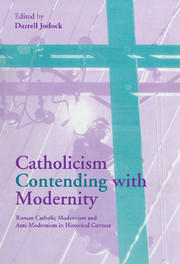 Catholicism Contending with Modernity
Catholicism Contending with Modernity Published online by Cambridge University Press: 30 October 2009
The previous chapters have examined several Modernists and several anti-Modernists. The overall argument of those chapters is that the theological position of neither group should be praised or blamed without first considering the following two questions: Why did the crisis develop when it did? Why did each individual involved in the Modernist crisis take the position that he or she did?
First, why did the crisis develop when it did? If one looks at the writings of the Catholic Tübingen School from the first half of the nineteenth century, it can be seen that the strictly theological issues had not changed very much in 100 years. What had changed was the cultural climate and the socio-political circumstances in which the church found itself. Various facets of that change have been explored in this volume, including the decreased temporal power of the Vatican, the development in France of a state-sponsored system of education which was independent of the church, the separation of church and state, and the declining credibility for many citizens of the church's claims to authority. The Modernists and the anti-Modernists both had to come to terms with these changes. The intensity of the crisis resulted from their radically divergent ways of undertaking the same task: while trying to convey the religious message of Catholic Christianity to the people of their day, the Modernists practiced selective accommodation, while the anti-Modernists practiced selective confrontation.
To save this book to your Kindle, first ensure [email protected] is added to your Approved Personal Document E-mail List under your Personal Document Settings on the Manage Your Content and Devices page of your Amazon account. Then enter the ‘name’ part of your Kindle email address below. Find out more about saving to your Kindle.
Note you can select to save to either the @free.kindle.com or @kindle.com variations. ‘@free.kindle.com’ emails are free but can only be saved to your device when it is connected to wi-fi. ‘@kindle.com’ emails can be delivered even when you are not connected to wi-fi, but note that service fees apply.
Find out more about the Kindle Personal Document Service.
To save content items to your account, please confirm that you agree to abide by our usage policies. If this is the first time you use this feature, you will be asked to authorise Cambridge Core to connect with your account. Find out more about saving content to Dropbox.
To save content items to your account, please confirm that you agree to abide by our usage policies. If this is the first time you use this feature, you will be asked to authorise Cambridge Core to connect with your account. Find out more about saving content to Google Drive.